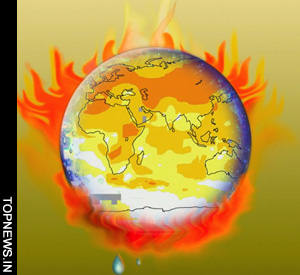Globe-warming CO2 already in danger zone
 Washington, Nov 19 : A revised theory by a group of 10 prominent scientists has suggested that the level of globe-warming carbon dioxide (CO2) in the air has already reached the danger zone, and the levels must decline, not just stabilize.
Washington, Nov 19 : A revised theory by a group of 10 prominent scientists has suggested that the level of globe-warming carbon dioxide (CO2) in the air has already reached the danger zone, and the levels must decline, not just stabilize.
According to the scientists, the CO2 has probably already reached a point where world climate will change disastrously unless the level can be reduced in coming decades.
The study, done by scientists from the United States, United Kingdom and France, is a departure from recent estimates that truly dangerous levels would be reached only later in this century.
The scientists said that CO2 now needs to be reduced to the level under which human civilization developed until the industrial age—about 350 parts per million (ppm)—to keep current warming trends from moving rapidly upward in coming years.
The level is currently at 385 ppm, and rising about 2 ppm each year, mainly due to the burning of fossil fuels and incineration of forests.
As a result, global temperatures have been creeping upward.
The authors said that improved data on past climate changes, and the pace at which earth is changing now, especially in the polar regions, contributed to their conclusion.
Among other things, ongoing observations of fast-melting ice masses that previously helped reflect solar radiation, and the release of stored-up “greenhouse” gases from warming soils and ocean waters, show that feedback processes previously thought to move slowly can occur within decades, not millennia, and thus warm the world further.
Once CO2 gas is released, a large fraction of it stays in the air for hundreds of years.
The scientists are optimistic that current atmospheric CO2 could be reduced if emissions from coal, the largest contributor, are largely phased out by 2030.
“There is a bright side to this conclusion,” said lead author James E. Hansen, director of the Goddard Institute for Space Studies, part of Columbia University’s Earth Institute. “By following a path that leads to lower CO2, we can alleviate a number of problems that had begun to seem inevitable,” he added.
According to Hansen, these include expanding desertification, reduced food harvests, increased storm intensities, loss of coral reefs, and the disappearance of mountain glaciers that supply water to hundreds of millions of people.
“Humanity today, collectively, must face the uncomfortable fact that industrial civilization itself has become the principal driver of global climate,” according to the research paper.
“The greatest danger is continued ignorance and denial, which would make tragic consequences unavoidable,” it added. (ANI)